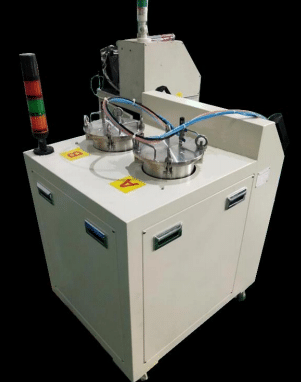Dispensing systems are integral to numerous industrial processes, offering precise control over the application of fluids such as adhesives, sealants, lubricants, and coatings. These systems ensure repeatability and accuracy, critical in industries like automotive, electronics, aerospace, and medical devices.

Types of Dispensing Systems Used in Industrial Settings
Dispensing systems are critical in industrial settings for accurately applying fluids such as adhesives, sealants, lubricants, and coatings. These systems come in various types, each suited to specific applications and requirements. Here are some common types of dispensing systems used in industries:
Piston Dispensers: Piston dispensers use a piston mechanism to dispense fluids. They are suitable for high-viscosity fluids and offer precise control over dispensing volume.
Gear Dispensers: Gear dispensers use gear pumps to dispense fluids. They are suitable for medium to high-viscosity fluids and provide consistent dispensing rates.
Time-Pressure Dispensers: Time-pressure dispensers use compressed air to dispense fluids. They are suitable for low to medium-viscosity fluids and offer adjustable dispensing pressure and volume.
Positive Displacement Dispensers: Positive displacement dispensers use a positive displacement pump to dispense fluids. They are suitable for high-precision dispensing of fluids with varying viscosities.
Robotic Dispensing Systems: Robotic dispensing systems use robotic arms to automate the dispensing process. They are suitable for high-volume production and offer precise control over dispensing parameters.
Automated Dispensing Machines: Automated dispensing machines are programmable machines that automate the dispensing process. They are suitable for a wide range of applications and offer high-speed dispensing with minimal operator intervention.
Auger Dispensers: Auger dispensers use an auger mechanism to dispense fluids. They are suitable for dispensing pastes and high-viscosity fluids and offer consistent dispensing rates.
Jetting Dispensers: Jetting dispensers use a jetting mechanism to dispense fluids. They are suitable for high-speed dispensing of fluids onto substrates and offer precise control over dispensing patterns.
Each type of dispensing system has its advantages and is chosen based on the specific requirements of the application, such as fluid viscosity, dispensing volume, dispensing speed, and accuracy.
Importance of Dispensing Systems in Industrial Settings
Dispensing systems are indispensable in industrial settings, playing a crucial role in ensuring the precise and controlled application of fluids such as adhesives, sealants, lubricants, and coatings. The importance of these systems can be observed across various industries, including automotive, electronics, aerospace, and medical devices.
Precision and Consistency
Dispensing systems provide precise control over the flow and volume of fluids, ensuring consistent application. This is essential for maintaining product quality and meeting stringent industry standards.
Efficiency and Cost-Effectiveness
By automating the dispensing process, these systems improve efficiency and reduce waste. They can accurately dispense the required amount of material, minimizing excess usage and saving costs.
Versatility and Adaptability
Dispensing systems are versatile and can be adapted to a wide range of applications and materials. They can handle various viscosities and types of fluids, making them suitable for diverse industrial needs.
Quality Assurance
The controlled dispensing offered by these systems enhances the quality of the final product. It reduces the likelihood of errors and defects, leading to higher customer satisfaction and reduced rework.
Safety and Compliance
Dispensing systems help ensure safety in the workplace by minimizing exposure to hazardous materials. They also help companies comply with regulatory requirements related to material usage and waste management.
Enhanced Productivity
By automating dispensing processes, these systems can significantly increase productivity. They can work continuously without fatigue, leading to faster production cycles and higher output.
Environmental Impact
Efficient dispensing systems can contribute to a reduction in material waste and environmental impact. They can help companies achieve sustainability goals by optimizing material usage and minimizing waste.
Factors to Consider When Choosing a Dispensing System for Industrial Applications
Selecting the right dispensing system is crucial for ensuring accurate and efficient dispensing of fluids in industrial settings. Several factors should be considered to choose the most suitable system for a specific application. Here are key factors to keep in mind:
Fluid Viscosity: The viscosity of the fluid being dispensed is a critical factor. Different dispensing systems are designed to handle fluids with varying viscosities. For high-viscosity fluids, piston or gear dispensers may be more suitable, while for low-viscosity fluids, time-pressure dispensers or jetting dispensers may be preferred.
Dispensing Volume: The required dispensing volume will determine the type of dispensing system needed. For small volumes, a precision dispensing system such as a positive displacement dispenser or an auger dispenser may be suitable. For larger volumes, a gear dispenser or a robotic dispensing system may be more appropriate.
Dispensing Speed: The speed at which the dispensing system can operate is important, especially in high-volume production environments. Robotic dispensing systems and automated dispensing machines are capable of high-speed dispensing, while manual dispensing guns may be slower.
Accuracy Requirements: The level of dispensing accuracy required for the application is another crucial factor. Systems like positive displacement dispensers and robotic dispensing systems offer high precision, while manual dispensing guns may be less accurate.
Material Compatibility: Ensure that the dispensing system is compatible with the material being dispensed. Some materials may require specialized dispensing systems to prevent corrosion or contamination.
Cost Considerations: The cost of the dispensing system, including initial investment, maintenance, and operating costs, should be considered. It’s essential to balance cost with the required performance and features.
Ease of Use and Maintenance: Choose a dispensing system that is easy to use and maintain, as this can affect productivity and downtime. Automated systems may require more complex maintenance procedures compared to manual systems.
Integration with Existing Equipment: Consider how the dispensing system will integrate with existing equipment and processes in your facility. Compatibility with other machinery and control systems is important for seamless operation.
By carefully considering these factors, you can select a dispensing system that meets your specific requirements and ensures efficient and reliable dispensing in your industrial application.
